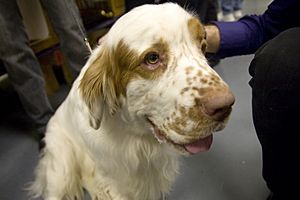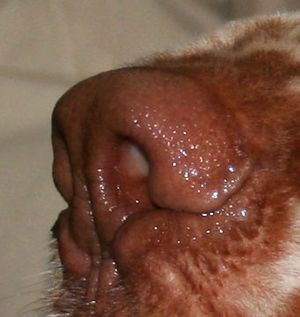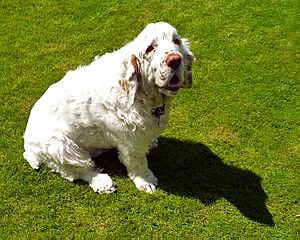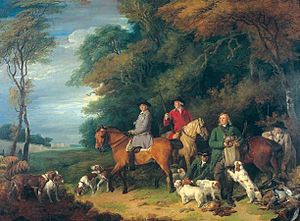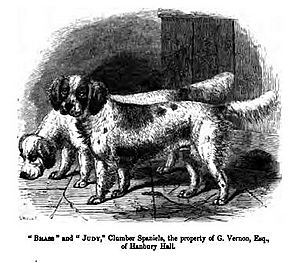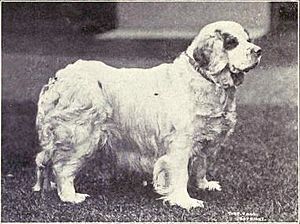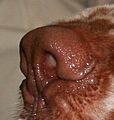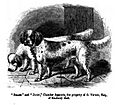Clumber Spaniel facts for kids
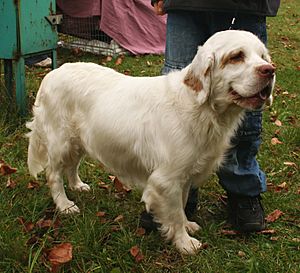
A Clumber Spaniel
|
||||||||
| Origin | England | |||||||
|---|---|---|---|---|---|---|---|---|
|
||||||||
| Domestic dog (Canis lupus familiaris) | ||||||||
The Clumber Spaniel is a special type of dog called a spaniel. It was first developed in the United Kingdom. It's the biggest spaniel breed! Most Clumber Spaniels are white with lemon or orange spots. This dog got its name from Clumber Park in Nottinghamshire, England, where it was first bred.
Clumber Spaniels are gundogs. This means they are trained to help hunters find and retrieve game. They are especially good at hunting in thick bushes. These dogs are gentle and loyal pets. They might act a bit shy around new people. Some things to know about them are that they shed their fur a lot and can snore loudly!
We don't know much about the breed's early history before the mid-1800s. There are two main ideas about where they came from. Many members of the British Royal Family have owned and bred Clumber Spaniels. This includes Prince Albert, King Edward VII, and King George V. The breed came to Canada in 1844. In 1884, it was one of the first ten breeds recognized by the American Kennel Club. Clumber Spaniels can have some health issues. These range from temporary leg problems when they are young to more serious conditions like hip dysplasia or back problems.
Contents
About the Clumber Spaniel
What They Look Like
The Clumber Spaniel is the largest of all the spaniel breeds. They have long, heavy bodies. They stand about 17 to 20 inches (43 to 51 cm) tall. They can weigh from 55 to 85 pounds (25 to 39 kg). Their body shape is similar to the smaller Sussex Spaniel.
Clumbers have strong bones. They have a big, "melting" head that can look a bit sad or sleepy. They have a square nose and muzzle. Their ears are large and shaped like vine leaves. It's common for them to have freckles on their muzzle and front legs. Their fur is thick and keeps them safe from bad weather. It's straight and flat, with longer hair (feathering) around their ears, belly, and legs. Most Clumbers are white. They have lemon, brown, or orange markings around their eyes and near the base of their tail.
Their Personality
Clumber Spaniels are known for being gentle, loyal, and loving dogs. However, they can be a bit reserved or shy with strangers. They often seem calm and enjoy relaxing on the couch, eating, and sleeping.
Clumber Spaniels shed a medium amount of fur. They need to be brushed and groomed often. They also tend to drool because of their loose lips. Clumbers are smart and can be a bit stubborn. Puppies are especially curious and love to play. These dogs often like to carry things around in their mouths. This "trophy mentality" can sometimes lead to health problems if they swallow things they shouldn't. Clumber Spaniels might be shy with other dogs at first. They need time to get used to them.
This breed has been used to hunt pheasant and partridge. They can hunt in small groups or alone. They are great for hunting in thick cover. Even though they are slower than other spaniels, they work quietly. They have a great sense of smell and lots of energy. Their wide muzzle helps them pick up different kinds of game. Clumber Spaniels are happy both indoors and outdoors. They are most content when they are with their owners. They don't bark very often. They are more like calm companions than guard dogs.
Health Concerns
Clumber Spaniels have large bones and grow quickly. Because of this, they can sometimes have temporary lameness (limping) between six and twelve months old. This usually goes away once their bones stop growing. Another common issue is impacted anal sacs. These might need to be emptied by a veterinarian. Clumbers are also sensitive to heat. If they are left without shade, they can get too hot and become dehydrated.
It can also be difficult for Clumbers to get pregnant and give birth. They sometimes need a C-section. Some dogs may also be sensitive to anesthesia. The most serious health problems for Clumber Spaniels are eye conditions, back problems, and hip problems. They usually live for about 10 to 12 years.
Eye Problems
Entropion is when the eyelid, usually the lower one, rolls inward. This can rub against the cornea (the clear part of the eye) and make it hard to see. It's a problem that can be passed down from parents to puppies. It's seen in many breeds, including some spaniels.
Ectropion is when the eyelid rolls outward. This leaves the eye exposed and can cause irritation. Because the eye is more exposed, the dog can get infections or dry eye syndrome. This is often seen in breeds with very loose facial skin.
Treating ectropion depends on how serious it is. For entropion, surgery is the only treatment. This surgery might be delayed until the dog is fully grown. This is because a puppy's face is still changing. Dogs who have surgery for these eye problems usually cannot compete in dog shows.
Back Problems
Spinal disc herniation happens when a disc between the bones in the spine bulges or breaks. This pushes on the spinal cord. When the spinal cord is squeezed, the dog can have pain in its back or neck. They might also have weak legs, lose feeling, or have trouble controlling their bladder or bowels. This problem most often happens in the middle of the back.
If the dog isn't paralyzed, they can be treated by resting them for several weeks. Pain medicine can also be given. Surgery can help a dog get feeling back in its legs if it was paralyzed. The success of surgery depends on how bad the disc problem was.
Hip Issues
Hip dysplasia is a condition that can be passed down through families. It affects many dog breeds. In 2001, a study by The Kennel Club in the UK showed that Clumber Spaniels had some of the worst scores for hip dysplasia. Another study found that almost half of Clumber Spaniels tested had this condition.
The first signs usually appear when the dog is between five and twelve months old. These signs can include a swaying walk, limping, weak muscles in the back legs, or not wanting to exercise. They might also have trouble climbing stairs or jumping. The dog might look hunched over with an arched back. In very bad cases, they might wince in pain when moving their back legs. Treatment can range from pain medication to surgery, depending on how serious the condition is.
History of the Breed
The history of the Clumber Spaniel before the mid-1800s is not very clear. One idea is that they came from France. It's said that during the French Revolution, the Duc de Noailles gave his valuable spaniels to the Duke of Newcastle at Clumber Park in Nottinghamshire. This theory suggests that these dogs were then bred with the now-extinct Alpine Spaniel, Basset Hounds, and the Pyrenean Mountain Dog.
Another idea is that Clumber Spaniels came from an old type of Bleinheim Spaniel. These were large hunting dogs, lemon and white in color. Today, the Bleinheim Spaniel is part of the much smaller King Charles Spaniel breed.
What we do know for sure is that the breed got its name from Clumber Park. The Duke of Newcastle's gamekeeper, William Mansell, is given credit for helping to develop and improve the breed. Prince Albert, who was married to Queen Victoria, loved and promoted the breed. His son, King Edward VII, also bred them at the Sandringham estate. Clumber Spaniels were first shown in England in 1859. Queen Victoria even wrote about them in her diary in 1840. She mentioned how her husband had "7 fine Clumber Spaniels" with them on a walk.
For a long time, only noble families bred Clumber Spaniels. During World War I, breeding almost stopped completely. This caused their numbers to drop very low. In 1925, King George V started a new line of Clumbers in the Royal Kennel. These dogs were used for hunting on the Sandringham Estate.
A famous Clumber Spaniel named Sh. Ch. Raycroft Socialite won "Best In Show" at the 1991 Crufts Centenary Show. This is a very important dog show.
Today, The Clumber Spaniel is considered a Vulnerable Native Breed by the UK Kennel Club. This means that fewer than 300 new puppies are registered each year. Other spaniel breeds on this list include the Field Spaniel, Irish Water Spaniel, and Sussex Spaniel.
Clumber Spaniels in North America
Clumber Spaniels were not widely shown in the United States until the late 1960s. However, in 1844, a British officer named Lieutenant Venables brought the Clumber Spaniel to North America. He was stationed in Halifax, Nova Scotia. The first Clumber Spaniel listed in the American Kennel Club (AKC) registry was named Bustler in 1878. He was an orange and white dog owned by Benjamin Smith of Nova Scotia. The Clumber Spaniel became one of the first ten breeds recognized by the AKC in 1884.
The first Clumber Spaniel was entered in the Westminster Kennel Club Dog Show in 1878. In 1996, a Clumber Spaniel named Champion Clussexx Country Sunrise ("Brady") won "Best in Show" at Westminster. This was a very big achievement!
Images for kids
See also
 In Spanish: Clumber spaniel para niños
In Spanish: Clumber spaniel para niños


